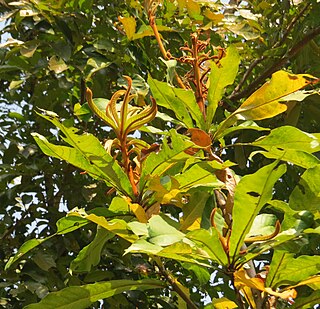
Madhuca longifolia is an Indian tropical tree found largely in the central and north Indian plains and forests. It is commonly known as oil-nut, madhūka, madkam, mahuwa, Butter Tree,mahua, mahwa, mohulo, or Iluppai or vippa chettu. It is a fast-growing tree that grows to approximately 20 meters in height, possesses evergreen or semi-evergreen foliage, and belongs to the family Sapotaceae. It is adaptable to arid environments, being a prominent tree in tropical mixed deciduous forests in India in the states of Odisha, Chhattisgarh, Jharkhand, Uttar Pradesh, Bihar, Maharashtra, Telangana, Madhya Pradesh, Kerala, Gujarat, West Bengal and Tamil Nadu.

Madhuca bourdillonii is a species of flowering plant in the family Sapotaceae. It is endemic to India, where it is known only from Kerala. Recent surveys failed to locate any specimens. The species has been exploited for its wood.
Madhuca calcicola is a species of plant in the family Sapotaceae. It is a tree endemic to Peninsular Malaysia. It is threatened by habitat loss.
Madhuca cuprea is a species of plant in the family Sapotaceae. It is a tree endemic to Peninsular Malaysia. The species is confined to rainforest in Perak. There is not enough information to determine whether it is endangered.

Madhuca diplostemon is a species of flowering plant in the family Sapotaceae, endemic to India. It is a threatened tree species of the Western Ghats whose original specimens were collected in 1835, and it was considered extinct for 184 years until a single living specimen was discovered in a sacred grove in Kollam district, when scientists at the Jawaharlal Nehru Tropical Botanic Garden and Research Institute (JNTBGRI) identified the tree as Madhuca diplostemon rather than the common attilippa.
Madhuca microphylla is a species of flowering plant in the family Sapotaceae. It is endemic to Sri Lanka, where it has been found in only two locations.
Madhuca moonii is a species of plant in the family Sapotaceae. It is endemic to Sri Lanka.
Madhuca oblongifolia is a species of plant in the family Sapotaceae. It is endemic to the Philippines. It is threatened by habitat loss.
Madhuca obovatifolia is a species of plant in the family Sapotaceae. It is endemic to the Philippines, where it is confined to Luzon. It is threatened by habitat loss.
Madhuca obtusifolia is a species of plant in the family Sapotaceae. It is a tree endemic to Peninsular Malaysia.
Madhuca penangiana is a species of plant in the family Sapotaceae. It is a tree endemic to Peninsular Malaysia. It is threatened by habitat loss.
Madhuca penicillata is a species of plant in the family Sapotaceae. It is a tree endemic to Peninsular Malaysia. It is threatened by habitat loss.
Madhuca rufa is a species of plant in the family Sapotaceae. It is a tree endemic to Peninsular Malaysia. It is threatened by habitat loss.
Madhuca sessiliflora is a species of plant in the family Sapotaceae. It is a tree endemic to Peninsular Malaysia. It is threatened by habitat loss.

Vateria indica, the white dammar, is a species of tree in the family Dipterocarpaceae. It is endemic to the Western Ghats mountains in India. It is threatened by habitat loss. It is a large canopy or emergent tree frequent in tropical wet evergreen forests of the low and mid-elevations.
Madhuca fusca is a tree in the family Sapotaceae. The specific epithet fusca means "very dark brown", referring to the indumentum.
Madhuca kuchingensis is a tree in the family Sapotaceae. It is named for the city of Kuching in Borneo.
Madhuca lancifolia is a tree in the family Sapotaceae. The specific epithet lancifolia means "lance-shaped leaves".
Madhuca spectabilis is a tree in the family Sapotaceae. The specific epithet spectabilis means "spectacular", referring to the tree's appearance.
Madhuca woodii is a tree in the family Sapotaceae. It is named for the botanist Geoffrey Wood.




